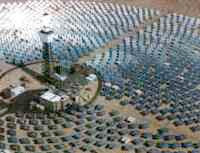Australian Power & Energy NewsTuesday 1/4/2008 Page: 32

CONSTRUCTION of the world's largest and most efficient solar
photovoltaic power station in northern Victoria will commence in 2009 following the signing of a $290 million Development Agreement between Melbourne-based business,
Solar Systems, and leading integrated energy company,
TRUEnergy.
TRUEnergy has provided $40 million to
Solar Systems in return for a 20 percent ownership interest. This investment will help ensure growth and continued success as the global leader in the development of concentrated
photovoltaics. In addition,
TRUEnergy will contribute seven million dollars to the development of a two
megawatt (MW)
heliostat concentrated
photovoltaic pilot plant, subsequently investing up to $285 million to build the remaining stages of the project, and adding to $129.5 million of Federal and Victorian Government funds already earmarked for the project.
Using high performance solar cells originally developed to power satellites, the $420 million full-sized
photovoltaic solar plant will produce 154MW of electricity, enough clean energy to power 45,000 homes. The project will also generate 950 new jobs during construction, a clear indication that the low emission technology sector is poised to flourish following the Federal Government's decision to ratify the
Kyoto Protocol late last year.
Announcing the deal,
TRUEnergy Managing Director, Richard Mclndoe said,"
TRUEnergy has moved quickly to secure a role in Australia's lucrative solar technology industry following the launch of its aggressive climate change strategy in July 2007. "
TRUEnergy's investment in the deployment of high performance solar
photovoltaic technology is convincing evidence of our willingness to reduce greenhouse emissions and respond to the challenges of climate change.
"This partnership will also allow
Solar Systems to start development of further solar energy projects across Australia and Asia at a crucial time when so many countries are looking to adopt renewable energy technologies in order to meet large scale emissions reduction targets.
"
TRUEnergy's investment in
Solar Systems will also provide for the development of one of the world's largest solar manufacturing facilities to supply concentrated solar
photovoltaic modules for use in the Northern Victorian power plant and at others around the world,' he said.
TRUEnergy's parent company, CLP, which has operations in Hong Kong, China, India, Taiwan, Thailand and Australia, has also entered into a ten year joint Development Agreement with
Solar Systems, to support the deployment of up to one
gigawatt (GW) of concentrated
photovoltaic technology across Asia Pacific Partnership countries.* Solar System's Managing Director, Dave Holland, welcomed the deal saying the Development Agreement with the
CLP Group would now guarantee the development of a significant new export industry for Australia.
"Last year, grants of $129.5 million from both the Victorian and Federal Governments significantly advanced Solar System's technology commercialisation processes, bringing mainstream
solar power closer to reality.
Solar Systems currently has another nine small power station systems under development in central Australia.
"Now, through this substantial Development Agreement with
TRUEnergy and CLP,
Solar Systems will be able to realise full commercial production and deployment of its proprietary solar
photovoltaic components, positioning Victoria at the centre for growth of a new international industry sector for which there is an extensive worldwide market. "Most importantly, construction of our new solar project will also make a significant contribution towards reducing Australia's environmental impact by reducing
greenhouse gas emissions by approximately 400,000 tonnes per year," he said.
TRUEnergy's twenty percent ownership interest in
Solar Systems further diversifies its already sizable energy generation portfolio, which includes the 400MW Tallawarra power station, Australia's most efficient gas-fired plant. When complete,
TRUEnergy Tallawarra will produce 70 percent less emissions than some coalfired generation facilities.
By 2030, we anticipate that more than $10 billion of commercially viable solar concentrator power plants, with a total capacity of over 5GW, will be rolled out across Australia. It is estimated that these plants will generate more than 10,000 new jobs in manufacturing and construction, as well as 1,870 new full-time direct jobs in maintenance and operation. The northern Victorian
solar power station project is planned to begin generation in 2010 and be fully completed by 2013.
*The
Asia Pacific Partnership for Clean Development and Climate (APP) is an initiative that engages the key greenhouse emitting countries across the region in the development/deployment of cleaner energy technologies.
 CHANCES are you've seen many turbines going up on the hills north-west of Ballarat. This week, the 28th turbine was erected at Waubra Wind Farm, with 100 more to go. Already, the locals are planning a festival to mark the wind farm's opening next year. Works are going well according to Acciona Energy construction manager Bruce Payne, but have depended on the weather. "During March and April, it was unseasonably windy, which posed the biggest challenge to the works," Mr Payne said.
CHANCES are you've seen many turbines going up on the hills north-west of Ballarat. This week, the 28th turbine was erected at Waubra Wind Farm, with 100 more to go. Already, the locals are planning a festival to mark the wind farm's opening next year. Works are going well according to Acciona Energy construction manager Bruce Payne, but have depended on the weather. "During March and April, it was unseasonably windy, which posed the biggest challenge to the works," Mr Payne said.



